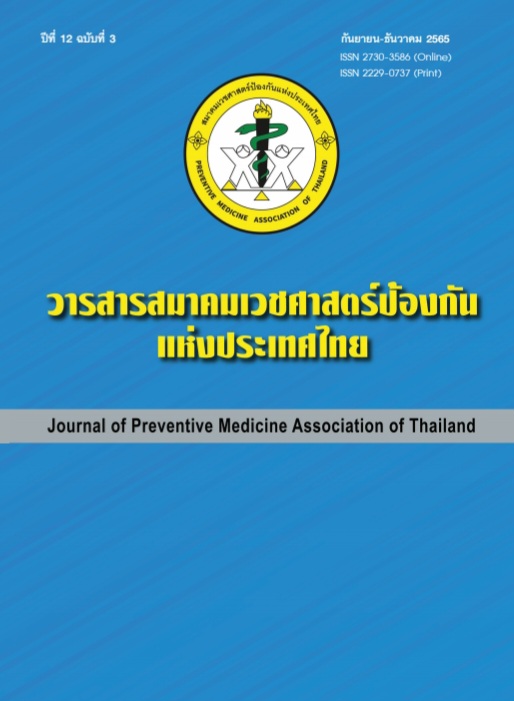COVID-19 Vaccine Side Effects in Children Aged 5-11 years in Thailand
Keywords:
adverse effects, COVID-19 vaccines, severityAbstract
This research was conducted with the objective to study the incidence of adverse outcomes from getting vaccines against Coronavirus 2019 (COVID-19) among children aged between 5 and 11 years with the method of a retrospective, cross-sectional study. The sample was from kindergarten 1 to elementary grade 6 students (along with their guardians) living in Thailand who received at least 1 dose of the vaccine regardless of the brand. The total number of participants was 1,232 people from the simple random method of schools’ name lists in Thailand. The data were collected from April to May 2022 via an online questionnaire as Google form, then were analyzed by both descriptive and inferential statistics with t-test and binary logistic regression to compare the incidence of side effects from COVID-19 vaccine between two age-group; of 5- to 8-year-old (kindergarten 1 to elementary grade 3) and 9- to 11-year-old (elementary grade 4 to 6). The result showed that there were 865 participants (70.21% of the total participants) reported at least 1 symptom of the side effects after vaccine administration within a month. The three most frequent reports of symptoms were local site pain (40.50%), myalgia (26.87%), and fatigue (12.42%). The older group suffered from adverse effects more than the younger one with the report of 563 people (71.99%) and 302 people (67.11%) respectively; however, the outcome showed no statistical difference significantly between these two groups in general (adjusted OR 1.26, 95%CI 0.96-1.64). The severity was more predominant among students who received the third dose than the first two doses. There was one patient admitted to a hospital with the diagnosis of myocarditis after COVID-19 vaccination; nevertheless, no fatal was reported for this study.
References
He X, Hong W, Pan X, Lu G, Wei X. SARS-CoV-2 Omicron variant: characteristics and prevention. Med Comm (2020) 2021;2(4):838-45
กรมควบคุมโรค. โรคติดเชื้อไวรัสโคโรนา 2019 (COVID-19) [อินเทอร์เน็ต]. 2563 [เข้าถึงเมื่อ 19 ม.ค. 2565]. เข้าถึงได้จาก: https://ddc.moph.go.th/viralpneumonia/situation.php
กรมควบคุมโรค. สถานการณ์เหตุการณ์ไม่พึงประสงค์หลังการได้รับวัคซีนป้องกันโรค COVID-19 [อินเทอร์เน็ต]. 2563 [เข้าถึงเมื่อ 19 ม.ค.2565]. เข้าถึงได้จาก: https://ddc.moph.go.th/viralpneumonia/situation.php
Sievertsen HH, Burgess S. Schools, skills, and learning: the impact of COVID-19 on education [Internet]. 2020 [cited 2022 Jan 18]. Available from: https://voxeu.org/article/impact-covid-19-education
Frenck RW Jr, Klein NP, Kitchin N, Gurtman A, Absalon J, Lockhart S, et al. Safety, immunogenicity, and efficacy of the BNT162b2 Covid-19 vaccine in adolescents. N Engl J Med 2021;385(3):239-50
Woodworth KR, Moulia D, Collins JP, Hadler SC, Jones JM, Reddy SC, et al. The advisory committee on immunization practices’ interim recommendation for use of Pfizer-BioNTech COVID-19 vaccine in children aged 5–11 years - United States, November 2021. MMWR Mord Mortal Wkly Rep 2021;70(45):1579-83.
Wu Z, Hu Y, Xu M, Chen Z, Yang W, Jiang Z, et al. Safety, tolerability, and immunogenicity of an inactivated SARS-CoV-2 vaccine (CoronaVac) in healthy adults aged 60 years and older: a randomised, double-blind, placebo-controlled, phase 1/2 clinical trial. Lancet Infect Dis 2021;21(6):803-12.
สำนักงานคณะกรรมการอาหารและยา. อย. อนุมัติวัคซีนไฟเซอร์ในกลุ่ม 5-11 ปี [อินเทอร์เน็ต]. 2564 [เข้าถึงเมื่อ 20 ธ.ค.2564]. เข้าถึงได้จาก: https://www.fda.moph.go.th/Pages/HomeP_D2.aspx
สำนักงานคณะกรรมการอาหารและยา. อย. อนุมัติวัคซีนซิโนแวคและซิโนฟาร์มในเด็ก 6 ปีขึ้นไป [อินเทอร์เน็ต]. 2564 [เข้าถึงเมื่อ 4 ก.พ.2565]. เข้าถึงได้จาก: https://www.fda.moph.go.th/Pages/HomeP_D2.aspx
Aguila MRD, Gonzalez-Ramirez A. Sample size calculation. Allergol Immunopathol (Madr) 2014;42(5):485-92.
Walter EB, Talaat KR, Sabharwal C, Gurtman A, Lockhart S, Paulsen GC, et al. Evaluation of the BNT162b2 Covid-19 vaccine in children 5 to 11 years of age. N Engl J Med 2022;386(1):35-46.
Berg SK, Wallach-Kildemoes HW, Rasmussen LR, Nygaard U, Bundgaard H, Petersen MNS, et al. Short and long term reported symptoms in adolescents aged 12-19 years after vaccination against SARS-CoV-2 compared to adolescents not vaccinated – a danish retrospective cohort study. Vaccines (Basel) 2022;10(11):1863.
World Health Organization. How do vaccine work? [Internet] 2020 [cited 2022 Dec 10]. Available from: https://www.who.int/news-room/feature-stories/detail/how-do-vaccines-work?gclid=Cj0KCQiA1sucBhDgARIsAFoytUuC_xEuswsXbJ2br-z4mxVQmwMtscvOXz685Tp8Nk25zMxKoyL2QU8aAuhfEALw_wcB
Lounis M, Rais MA, Bencherit D, Aouissi HA, Oudjedi A, Klugarova J, et al. Side effects of COVID-19 inactivated virus vs. adenoviral vector vaccines: experience of Algerian healthcare workers. Frontiers in Public Health 2022;10:896343.
Infectious Disease Advisor. COVID-19 mRNA vaccine lined to higher adverse event risk vs traditional vaccines [Internet]. 2022 [2022 Dec 10]. Available from: https://www.infectiousdiseaseadvisor.com/home/topics/covid19/safety-and-risks-of-covid-19-mrna-vaccines-compared-with-other-vaccines/
Oster ME, Shay DK, Su JR, Gee J, Creech CB, Broder KR, et al. Myocarditis case reported after mRNA-Based COVID-19 vaccination in the US From December 2020 to August 2021. JAMA 2022;327(4):331-40.
Downloads
Published
Versions
- 2023-01-17 (2)
- 2023-01-16 (1)
How to Cite
Issue
Section
License
Copyright (c) 2023 Journal of Preventive Medicine Association of Thailand

This work is licensed under a Creative Commons Attribution-NonCommercial-NoDerivatives 4.0 International License.
บทความที่ลงพิมพ์ในวารสารเวชศาสตร์ป้องกันแห่งประเทศไทย ถือเป็นผลงานวิชาการ งานวิจัย วิเคราะห์ วิจารณ์ เป็นความเห็นส่วนตัวของผู้นิพนธ์ กองบรรณาธิการไม่จำเป็นต้องเห็นด้วยเสมอไปและผู้นิพนธ์จะต้องรับผิดชอบต่อบทความของตนเอง





